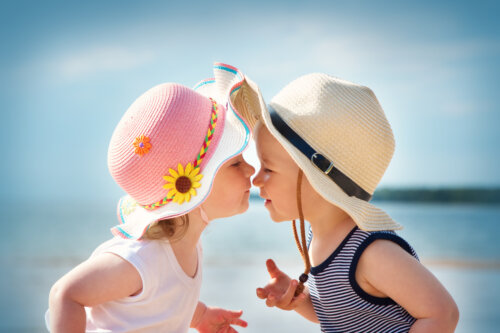Why Some Children Kiss Each Other on the Mouth?

When young children begin to expand their social world beyond their family, new and challenging situations begin to present themselves to parents and other reference figures. One of the most frequently asked questions has to do with why some children kiss each other on the mouth, which causes uncertainty and surprise in their parents. What’s behind this action, how can we interpret it, and what should we do? Let’s learn a little more about it in the following article.
Is it normal when children kiss each other on the mouth?
Yes, kisses on the mouth between children are completely normal. There’s nothing to be afraid of. They’re part of affection and their developing emotional world. At the same time, you should also keep in mind that it may be because of something they’ve seen at home, for example, a display of affection between their parents. There are even parents who tend to do this with their children. Therefore, for children, it’s not a bad thing, but quite the opposite.
You may be interested in: Children Have a Right Not to Kiss If They Don’t Want To

Some keys regarding kissing on the mouth between children
As we’ve seen, when children kiss each other on the mouth, this is a completely normal occurrence. Here, we’ll share with you some keys in order to better understand the situation.
Don’t interpret it as a situation of young people or adults
First, it’s important to normalize this situation and to be able to move away from the adult interpretation, as children operate within a different framework of meaning. They don’t think in terms of sex, but for children, kissing in the mouth is part of their exploration and knowledge of the world. Also, it’s about play and curiosity.
Talk about boundaries and intimacy
It’s important to raise the issue of boundaries, intimacy, and respect. In this regard, it’s important to point out that we don’t give kisses on the mouth to everyone, much less to strangers. In the same way, we don’t give kisses to those who don’t want them, nor do we have to give kisses if we don’t want to.
Explain in a simple way
According to the child’s age, it’s appropriate to start with simple explanations, check if it’s enough, and then advance and make it more complex if necessary. The most important thing is not to close off dialogue or take away the possibility for them to ask more questions. Because if they can’t ask these questions at home, where will they look for answers?
Don’t make fun of the situation
Whether you’ve seen it or it was the child who told you about kissing someone on the mouth at preschool, don’t respond with mockery. This may make them feel bad or lead them to think there’s something wrong with it, and then they may not want to tell you anymore. In the end, you’ll lose the opportunity for them to trust you.
Banish certain myths
It’s also important to banish the myth and fear that allowing these behaviors encourages early sexuality. Here are two points to keep in mind:
- We must understand that sexuality is present from the first moment, although it changes form over time. It’s a constitutive dimension comprising psychological, biological, cultural, and social aspects. In turn, it’s expressed in beliefs, behaviors, thoughts, desires, practices, and roles, according to the definition offered by the World Health Organization. Therefore, sexuality transcends sex.
- We must visualize that it’s not a question of encouraging it or not, but the opposite. It’s something that’s completely normal in the lives of human beings that shouldn’t be treated as a taboo.

When should we be concerned?
While kissing on the mouth between children is normal, there are some situations that warrant intervention or consultation with a specialist:
- When the behaviors we observe exhibit a certain sexualization that’s not age-appropriate. That is, when they’re not in accordance with the child’s maturational development. In these cases, for example, we can start by paying attention to what kind of television programs, videos, or content they have access to.
- When we observe discomfort when children kiss others on the mouth as if they were only doing it to please others or out of obligation
- If the age difference with the other kissing child is noticeable.
You may be interested in: When to Talk to Your Children About Sex
Review your own prejudices
At early ages, addressing the topic of sexuality is related to the knowledge and care of one’s own body. Also, with respect for one’s own and others’ rights and limits, and with the expression of emotions and affection. In this regard, there’s nothing to fear, but a great deal to teach.
As adults, in order to accompany the education and upbringing of our children, it’s important to review our own assumptions and fears. It’s these prejudices that see problematic situations where there are none and prevent us from engaging with certain topics. In this regard, you don’t have to have all the answers, but it’s important to have the motivation and interest to look for them. Only when we can clarify our own prejudices will we be able to provide our children with the resources and tools to enjoy sexuality in a full, careful, and responsible way.
All cited sources were thoroughly reviewed by our team to ensure their quality, reliability, currency, and validity. The bibliography of this article was considered reliable and of academic or scientific accuracy.
- García-Piña CA. Sexualidad infantil: información para orientar la práctica clínica. Acta Pediatr Mex 2016;37:47-53.
- Educación sexual integral para la educación inicial : contenidos y propuestas para las salas. – 1a ed. – Buenos Aires : Ministerio de Educación de la Nación, 2010
